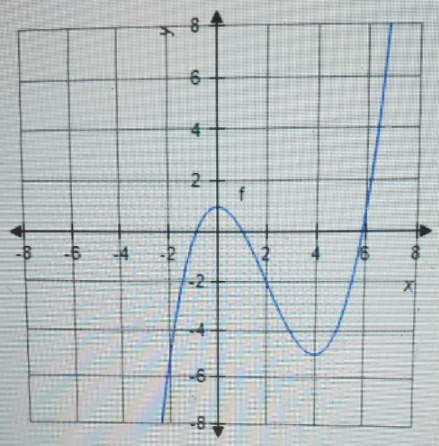The graph of fis shown below. For which values of x is f'(x) zero? Select one: O b. 6 e. 4 2 a. x = -2; x = 1 x = 2; x = 0 C. x=0; x = 6 O d. x=0; x = 4 -2 x=0; x = -1 f X
The graph of fis shown below. For which values of x is f'(x) zero? Select one: O b. 6 e. 4 2 a. x = -2; x = 1 x = 2; x = 0 C. x=0; x = 6 O d. x=0; x = 4 -2 x=0; x = -1 f X
Calculus: Early Transcendentals
8th Edition
ISBN:9781285741550
Author:James Stewart
Publisher:James Stewart
Chapter1: Functions And Models
Section: Chapter Questions
Problem 1RCC: (a) What is a function? What are its domain and range? (b) What is the graph of a function? (c) How...
Related questions
Question

**Description of the Graph:**
The graph represents the function \( f(x) \), and it shows a curve that moves through several points as follows:
- The curve starts from the left, rising from negative \( y \)-values, peaking around the point \( (-2, 2) \).
- It then falls back through the origin, reaching a local minimum near \( (1, -2) \).
- The curve continues upward, rising sharply beyond \( x = 6 \).
The graph intersects the x-axis at the origin (0,0) and between x = 1 and x = 2. It has horizontal tangents (indicative of zero derivatives) at the peak point near \( x = -2 \) and the trough near \( x = 1 \).
**Options:**
Select one:
- a. \( x = -2; x = 1 \)
- b. \( x = 2; x = 0 \)
- c. \( x = 0; x = 6 \)
- d. \( x = 0; x = 4 \)
- e. \( x = 0; x = -1 \)
**Explanation:**
The graph of \( f \) shows horizontal tangents (where the derivative \( f'(x) \) is zero) at local maxima and minima. Based on the description, the function has such points at approximately \( x = -2 \) and \( x = 1 \). Therefore, the correct answer is option (a): \( x = -2; x = 1 \).](/v2/_next/image?url=https%3A%2F%2Fcontent.bartleby.com%2Fqna-images%2Fquestion%2Fa89fcfbc-9661-4037-a401-8de41697cbc3%2F9784385c-bfa7-4253-b297-68d5018d9714%2F8v6tvk_processed.jpeg&w=3840&q=75)
Transcribed Image Text:**Question:**
The graph of \( f \) is shown below. For which values of \( x \) is \( f'(x) \) zero?

**Description of the Graph:**
The graph represents the function \( f(x) \), and it shows a curve that moves through several points as follows:
- The curve starts from the left, rising from negative \( y \)-values, peaking around the point \( (-2, 2) \).
- It then falls back through the origin, reaching a local minimum near \( (1, -2) \).
- The curve continues upward, rising sharply beyond \( x = 6 \).
The graph intersects the x-axis at the origin (0,0) and between x = 1 and x = 2. It has horizontal tangents (indicative of zero derivatives) at the peak point near \( x = -2 \) and the trough near \( x = 1 \).
**Options:**
Select one:
- a. \( x = -2; x = 1 \)
- b. \( x = 2; x = 0 \)
- c. \( x = 0; x = 6 \)
- d. \( x = 0; x = 4 \)
- e. \( x = 0; x = -1 \)
**Explanation:**
The graph of \( f \) shows horizontal tangents (where the derivative \( f'(x) \) is zero) at local maxima and minima. Based on the description, the function has such points at approximately \( x = -2 \) and \( x = 1 \). Therefore, the correct answer is option (a): \( x = -2; x = 1 \).
Expert Solution
Step 1
Given
The graph of

Step by step
Solved in 2 steps with 1 images

Recommended textbooks for you

Calculus: Early Transcendentals
Calculus
ISBN:
9781285741550
Author:
James Stewart
Publisher:
Cengage Learning

Thomas' Calculus (14th Edition)
Calculus
ISBN:
9780134438986
Author:
Joel R. Hass, Christopher E. Heil, Maurice D. Weir
Publisher:
PEARSON

Calculus: Early Transcendentals (3rd Edition)
Calculus
ISBN:
9780134763644
Author:
William L. Briggs, Lyle Cochran, Bernard Gillett, Eric Schulz
Publisher:
PEARSON

Calculus: Early Transcendentals
Calculus
ISBN:
9781285741550
Author:
James Stewart
Publisher:
Cengage Learning

Thomas' Calculus (14th Edition)
Calculus
ISBN:
9780134438986
Author:
Joel R. Hass, Christopher E. Heil, Maurice D. Weir
Publisher:
PEARSON

Calculus: Early Transcendentals (3rd Edition)
Calculus
ISBN:
9780134763644
Author:
William L. Briggs, Lyle Cochran, Bernard Gillett, Eric Schulz
Publisher:
PEARSON

Calculus: Early Transcendentals
Calculus
ISBN:
9781319050740
Author:
Jon Rogawski, Colin Adams, Robert Franzosa
Publisher:
W. H. Freeman


Calculus: Early Transcendental Functions
Calculus
ISBN:
9781337552516
Author:
Ron Larson, Bruce H. Edwards
Publisher:
Cengage Learning